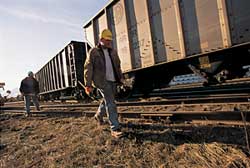A Cure for Common Foot Hazards
Prevention and training are the keys to a successfully implemented safety footwear program.
- By Jeff Goodwin
- Jul 01, 2005
 IMAGINE this: An employee walks into a hazardous workplace environment and sustains a foot injury that could have been prevented. While the employee must now endure a painful injury and lost time from work, his employer is faced with a dip in productivity and exposure to a potentially damaging worker's compensation claim.
IMAGINE this: An employee walks into a hazardous workplace environment and sustains a foot injury that could have been prevented. While the employee must now endure a painful injury and lost time from work, his employer is faced with a dip in productivity and exposure to a potentially damaging worker's compensation claim.
Now you can stop imagining, because this is a scenario that occurs every day in a multitude of workplace environments throughout the United States. The fact is, this scenario could have been prevented or minimized through the implementation of a safety footwear program and proper training.
The occurrence of on-the-job foot injuries is as common in industry as they are preventable. When a job requires a worker to stand on his feet for long periods of time and work in potentially hazardous areas or with potentially hazardous materials, there will be some risk of foot injury. With the proper foot protection and training, a significant number of injuries and lost workday accidents could be prevented.
Foot Injury Statistics
Statistics tell the story of the importance of preventing foot injuries:
* According to the Bureau of Labor Statistics, more than 60,000 foot injuries per year result in lost work days.
* BLS cites a study of foot injuries that found 75 percent of the injuries occurred when workers were not in compliance.
* According to the National Council on Compensation Insurance, the average cost of a lost work day foot injury is $9,600.
* Eighty percent of all footwear injuries are caused by an object weighing no more than 30 pounds impacting the foot.
Hazards and Protections
Several hazards are common in the workplace today. However, the probability of an injury occurring can be greatly minimized or eliminated with a structured training program and proper foot protection designed specifically for those workplace environments. Listed below are some of the common workplace hazards and what can be done to prevent them:
* Falling and rolling objects, cuts and punctures. Injuries could include crushed or broken feet, amputations of toes or feet, punctures of feet or toes.
Protection: Steel or composite toe safety footwear, metatarsal guards, puncture-resistant footwear. Shoes should be ASTM F2413-05 compliant.
* Chemicals, solvents. Injuries could include chemical burns, skin irritation, and exposure.
Protection: Leather safety footwear with synthetic stitching, Rubber, vinyl, plastic, or PVC compound boots or overshoes.
* Electrical current, high voltage. Injuries could include electrical shocks or fatal electrical exposure.
Protection: Safety footwear should incorporate an electrical hazard (EH) protective sole and heel. The sole construction should be designed to reduce hazards from contact with electrically energized parts. It also should provide a secondary electrical hazard protection on substantially insulated surfaces. Footwear should be designed to provide protection from open circuits of 600 volts or less under dry conditions. Properties should include the ability to withstand 14,000 volts (rms) at 60Hz for one minute with no leakage in excess of 3.0 milliamperes.
* Extreme cold. Injuries could include frostbite and permanent tissue damage or loss, as well as causing discomfort.
Protection: Insulated footwear that captures the body's heat, preventing it from escaping; footwear that is waterproof/water resistant, which will prevent feet from getting wet, thereby facilitating keeping feet warm.
* Slips, trips and falls. Injuries include falls, back sprains, ankle sprains, and disabling injuries.
Protection: Safety shoes with soles that are non-slip rubber, urethane, or crepe; footwear that wraps around and laces tight around the ankle to prevent sprains and twisting.
* Wet environments. Injuries could include slips and falls, back sprains, ankle sprains, strains, and disabling injuries.
Protection: Lined rubber boots with waterproof characteristics; safety shoes with soles that are non-slip rubber, urethane, or crepe.
Footwear Safety Programs
Today, many companies offer their employees safety footwear through company-sponsored purchasing programs. Offering such a program is a great way to help ensure employee safety and assist employees in choosing the correct footwear for the job.
Several footwear companies offer a variety of safety footwear purchase programs. Most offer relatively similar products and services (i.e., retail outlets, on-site mobile distribution, in-house commissary stores, and direct-to-industry mail order programs). In selecting a program, you want to make sure your company's particular needs are addressed.
Proper safety footwear alone will not prevent all accidents. You should develop a safety footwear program that incorporates both footwear selection and proper use and maintenance of that footwear. This process is usually preceded by performing a hazard assessment of the workplace. The hazard assessment, in conjunction with the footwear selection and training process, helps to ensure that hazards are minimized and employees are in compliance with the employer's policies.
Prevention and training are the keys to a successfully implemented safety footwear program.
This article appears in the July 2005 issue of Occupational Health & Safety.
This article originally appeared in the July 2005 issue of Occupational Health & Safety.